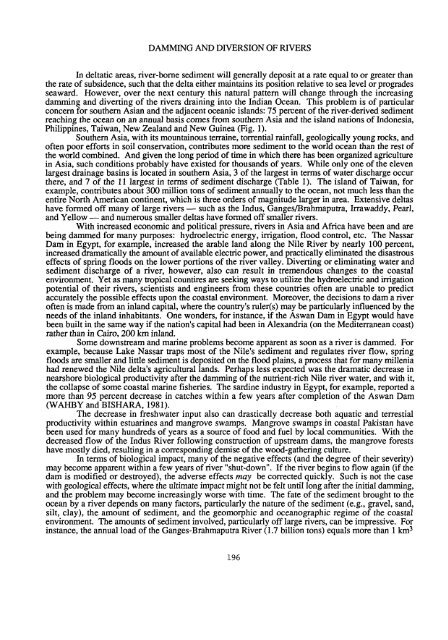139736eo.pdf (20MB) - Japan Oceanographic Data Center
139736eo.pdf (20MB) - Japan Oceanographic Data Center
139736eo.pdf (20MB) - Japan Oceanographic Data Center
- No tags were found...
Create successful ePaper yourself
Turn your PDF publications into a flip-book with our unique Google optimized e-Paper software.
DAMMING AND DIVERSION OF RIVERSIn deltatic areas, river-borne sediment will generally deposit at a rate equal to or greater thanthe rate of subsidence, such that the delta either maintains its position relative to sea level or progradesseaward. However, over the next century this natural pattern will change through the increasingdamming and diverting of the rivers draining into the Indian Ocean. This problem is of particularconcern for southern Asian and the adjacent oceanic islands: 75 percent of the river-derived sedimentreaching the Ocean on an annual basis comes from southern Asia and the island nations of Indonesia,Philippines, Taiwan, New Zealand and New Guinea (Fig. 1).Southern Asia, with its mountainous terraine, torrential rainfall, geologically young rocks, andoften poor efforts in soil conservation, contributes more sediment to the world ocean than the rest ofthe world combined, And given the long period of time in which there has been organized agriculturein Asia, such conditions probably have existed for thousands of years. While only one of the elevenlargest drainage basins is located in southern Asia, 3 of the largest in terms of water discharge occurthere, and 7 of the 11 largest in terms of sediment discharge (Table 1).The island of Taiwan, forexample, contributes about 300 million tons of sediment annually to the ocean, not much less than theentire North American continent, which is three orders of magnitude larger in area. Extensive deltashave formed off many of large rivers - such as the Indus, GangesDrahmaputra, Irrawaddy, Pearl,and Yellow - and numerous smaller deltas have formed off smaller rivers.With increased economic and political pressure, rivers in Asia and Africa have been and arebeing dammed for many purposes: hydroelectric energy, irrigation, flood control, etc. The NassarDam in Egypt, for example, increased the arable land along the Nile River by nearly 100 percent,increased dramatically the amount of available electric power, and practically eliminated the disastrouseffects of spring floods on the lower portions of the river valley. Diverting or eliminating water andsediment discharge of a river, however, also can result in tremendous changes to the coastalenvironment. Yet as many tropical countires are seeking ways to utilize the hydroelectric and irrigationpotential of their rivers, scientists and engineers from these countries often are unable to predictaccurately the possible effects upon the coastal environment. Moreover, the decisions to dam a riveroften is made from an inland capital, where the country's ruler(s) may be particularly influenced by theneeds of the inland inhabitants. One wonders, for instance, if the Aswan Dam in Egypt would havebeen built in the same way if the nation's capital had been in Alexandria (on the Mediterranean coast)rather than in Cairo, 200 km inland.Some downstream and marine problems become apparent as soon as a river is dammed. Forexample, because Lake Nassar traps most of the Nile's sediment and regulates river flow, springfloods are smaller and little sediment is deposited on the flood plains, a process that for many milleniahad renewed the Nile delta's agricultural lands. Perhaps less expected was the dramatic decrease innearshore biological productivity after the damming of the nutrient-rich Nile river water, and with it,the collapse of some coastal marine fisheries. The sardine industry in Egypt, for example, reported amore than 95 percent decrease in catches within a few years after completion of the Aswan Dam(WAHBY and BISHARA, 1981).The decrease in freshwater input also can drastically decrease both aquatic and terrestialproductivity within estuarines and mangrove swamps. Mangrove swamps in coastal Pakistan havebeen used for many hundreds of years as a source of food and fuel by local communities. With thedecreased flow of the Indus River following construction of upstream dams, the mangrove forestshave mostly died, resulting in a corresponding demise of the wood-gathering culture.In terms of biological impact, many of the negative effects (and the degree of their severity)may become apparent within a few years of river "shut-down". If the river begins to flow again (if thedam is modified or destroyed), the adverse effects may be corrected quickly. Such is not the casewith geological effects, where the ultimate impact might not be felt until long after the initial damming,and the problem may become increasingly worse with time. The fate of the sediment brought to theocean by a river depends on many factors, particularly the nature of the sediment (e.g., gravel, sand,silt, clay), the amount of sediment, and the geomorphic and oceanographic regime of the coastalenvironment. The amounts of sediment involved, particularly off large rivers, can be impressive. Forinstance, the annual load of the Ganges-Brahmaputra River (1.7 billion tons) equals more than 1 km319 6
















